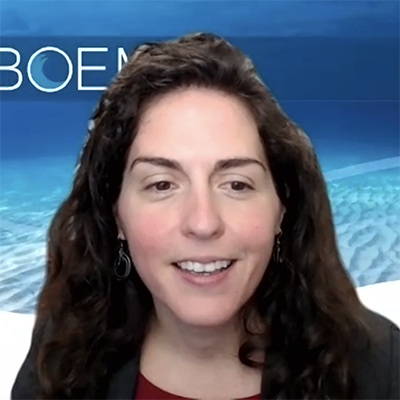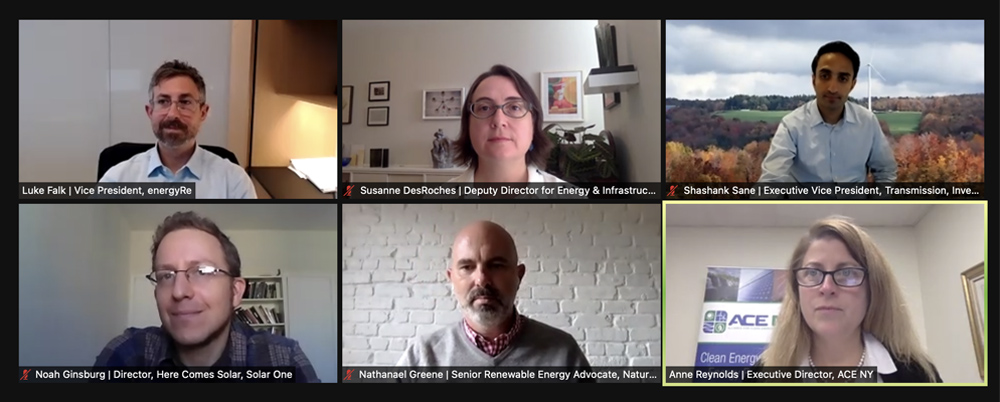
New York City is set to replace its dirty power plants with clean energy from up the Hudson River and in the ocean, with an estimated $26 billion in state-sponsored projects about evenly divided between the two.
 BOEM Director Amanda Lefton | ACE-NY
BOEM Director Amanda Lefton | ACE-NYAnd more projects are coming offshore, as the Bureau of Ocean Energy Management will auction new lease areas in the New York Bight in early 2022, Director Amanda Lefton said Thursday.
“Our path includes up to seven new offshore lease sales by 2025, including those in the Gulf of Maine, the New York Bight, the central Atlantic offshore the Carolinas, in California, Oregon and maybe even the Gulf of Mexico,” Lefton said at the Alliance for Clean Energy New York (ACE-NY) Fall Conference.
This is the first time BOEM has released a roadmap of regions under consideration for lease as well as potential timeframes, Lefton said.
“By providing clear direction on our path, we’re trying to remove the guesswork and inspire confidence among industry ocean users and other stakeholders,” she said.
Transmission Focus
State agencies have approved two separate projects totaling 2,550 MW to bring solar, wind and hydropower south to the city, as well as offshore wind projects totaling 4,300 MW. (See Two Transmission Projects Selected to Bring Low-carbon Power to NYC.)
The one-two punch in New York is meant to solve the transmission bottlenecks limiting power flows to the city, ending the familiar tale of two grids that leaves renewable and nuclear energy predominantly serving the upstate areas where it is generated.
 Clockwise from top left: Luke Falk, energyRe; Susanne DesRoches, NYC Mayor’s Office; Shashank Sane, Invenergy; Anne Reynolds, ACE-NY; Nathanael Greene, NRDC; and Noah Ginsburg, Solar One. | ACE-NY
Clockwise from top left: Luke Falk, energyRe; Susanne DesRoches, NYC Mayor’s Office; Shashank Sane, Invenergy; Anne Reynolds, ACE-NY; Nathanael Greene, NRDC; and Noah Ginsburg, Solar One. | ACE-NY
New York has struggled with land-based transmission planning, but “it’s just super complicated” to get several different states and several different RTOs together to plan for offshore transmission, ACE-NY Executive Director Anne Reynolds said.
“What’s going to be really critical is thinking about a planned approach, and we really have key challenges,” Lefton said. “We have interconnection, the availability of onshore transmission … something that’s been incredibly clear is that we need a strong collaborative effort between states and the federal government.” (See NY Grid Study Pushes Meshed OSW Tx, Coordination.)
New York is unique by its nature, but the region needs to come together to ensure that there are adequate points of interconnection, she said.
“The biggest takeaway on what states can do is to partner to really try and be proactive about solving some of these transmission issues rather than reactive,” Lefton said.
The $11 billion, 174-mile, 1,300-MW Clean Path New York project under the Hudson River would allow a greater flow of energy between upstate and downstate, said Shashank Sane, executive vice president of transmission at Invenergy, one of the project’s developers. Primarily intended to deliver clean energy into New York City, the project would also help ensure reliability for the state’s grid, he said.
Powering NYC with Renewables
The state is set to connect 9 GW of offshore wind into New York City by 2035, said Nathanael Greene, senior renewable energy advocate at the Natural Resources Defense Council.
“For context, the summer peak load in [the city] is about 11.5 GW, so if we connected about 6 GW of offshore wind, you can see that would make a real big contribution,” Greene said.
But the solar industry faces a lot of headwinds, noted Noah Ginsburg, director of Here Comes Solar at Solar One, which works in the city. Half of a statewide community solar program was taken up by natural gas systems that essentially exploited a loophole in the program with some financing from the New York Green Bank, he said, and the Public Service Commission has approved utilities statewide to impose a new fee on net-metered solar customers starting in January.
“The combination of those two things is really going to impede growth in the solar industry,” Ginsburg said. “It’s as if New York has decided it’s buying a Tesla, so [it has] stopped changing the oil on its Honda Civic.”
“We have a unique situation in New York City,” said Susanne DesRoches, deputy director for energy and infrastructure in the mayor’s Office of Climate and Sustainability. “Not only are we constrained by existing transmission, but we also have a very old and polluting fleet that essentially we’re required to have by reliability rules.”
The challenge is to ensure a reliable and resilient clean energy transition while bringing on renewable energy resources and taking those old power plants offline, she said.
“We’re expecting to see days over 90 degrees [Fahrenheit] triple in New York City. We’ve had some historic rainfall events just in the last few months tragically killing 13 New York City residents … so we have to pivot very quickly to new and clean resources and make sure we’re making those resources resilient to what’s coming,” DesRoches said.
The mayor’s office is very concerned that about 1.5 million New York City residents spend more on energy than the state target of 6% of a person’s income, she said.
